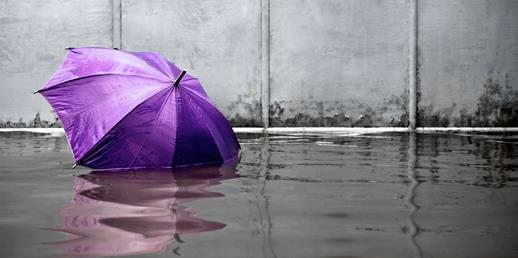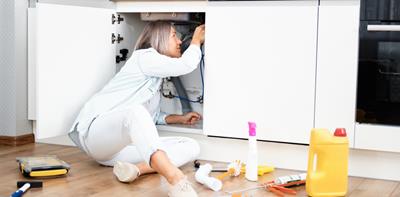
Taking preventative measures to help your home withstand high winds and heavy rain is easier than fixing storm damage afterwards. Autumn is a good time to prepare your home for a winter storm. Read on for our guide to preventing storm damage and preparing for high winds.
EASY AS HACK
Download the Met Office app and set up alerts for storm warnings in your area
At a glance
- Secure your windows, doors and garden gates before storms and high winds.
- Check your roof and gutters regularly for holes, leaks and any debris that could lead to a flood.
- Avoid driving in a storm. Park your car safely away from trees and power lines.
how to check if a storm is coming
To find out if a storm is coming, check the weather forecast on the Met Office website, or download their app and set up storm alerts.
You can also keep up with weather warnings on local radio, TV and social media. In the UK, any storm that is likely to cause significant damage will be given a name.
You can check if your home is in a flood risk area on the Gov.uk website.
preparing for a storm
close all windows and doors
Secure all your exterior windows and doors, especially large doors like the entrance to a garage. Make sure all your windows and doors are tight and sealed shut. Check your loft hatch is secure too, if you have one.
check the roof, pipes and gutters
Anywhere that water runs is an important place to check ahead of a storm.
You may wish to contact a professional roofer to inspect for any missing or loose tiles, as well as general wear and tear. Flat roofs are also worth inspecting, as signs of wear and tear may indicate structural weakness. This could affect their ability to withstand rain, snow, or storm debris such as fallen branches. It’s also a good idea to check the roofs of garages and sheds to ensure they’re in good condition.
Checking your gutters is also important. Make sure there’s no debris or moss and leaves in your gutters, downspouts, gallies and drains. This means heavy rainfall can pass freely and quickly, helping to prevent flooding. In cold weather, water trapped in blocked drains can freeze and damage the pipes – another reason to keep gutters, pipes and drains clear year-round.
Equally important is carrying out regular checks and maintenance on your roof, gutters, pipes, and window seals. Small issues like loose tiles, cracked seals, or minor leaks can worsen over time if left unattended, potentially leading to structural damage and unexpected repair bills.
Always take care and use a professional if your gutters are difficult to access.
secure outside before the storm
Secure anything that has the potential to be damaged, or do damage, during a storm, such as a trampoline. Put any parasols or lawnmowers away safely in the shed. Bring your garden furniture inside if you can. If you have outside bins either find a way to secure them or bring them inside.
Make sure your fences and gates are in a good state of repair and as secure as possible. While they may not completely escape damage, you can minimise it by making them secure. Fences and gates are not usually covered under home insurance, so it’s worth checking your policy.
park your car safely
Park your car as safely as you can before the storm. If you have a garage, park your car inside it. If not, try to park your car away from anything that may cause damage, such as trees and power lines.
what to do during a storm
The most important thing is to stay safe. Stay indoors until the storm has passed and don’t leave your home unless it is an emergency. Don’t walk, cycle or drive anywhere.
If you notice the storm has damaged the outside of your house or your garden, don’t try to repair it while the storm is still going on.
Avoid using a landline telephone in a storm unless it’s an emergency because telephone lines can conduct electricity from lightning.
what should you do after a storm?
If any electrical or telephone cables have been blown down, don’t touch them. Wait for a professional to come and repair them.
Try not to walk too closely to any walls or buildings, as they may have been damaged during the storm.
Make sure any vulnerable neighbours are safe and get help for anyone who needs it.
does home insurance cover storm damage?
Home insurance usually covers wind and storm damage as long as the weather event meets the definition of each insurer. This can be found in the policy documents. Ageas uses the following definition:
By a storm, we mean strong winds of over 55mph, or damage by extreme rain, snow, or hail. Rainfall is extreme if more than 2.5cm falls in an hour. Snowfall is extreme if 30cm or more falls in a 24-hour period. Hail is extreme if it damages hard surfaces.
Even if you’re covered for storm damage, it’s a good idea to check your buildings or contents insurance.
Find out if Ageas covers wind damage
what is not covered by storm damage?
You should always check your policy documents so you can see exactly what you are and are not covered for when it comes to storm damage. It is best to start with the definition of a storm as provided by the insurer.
Damage to gates and fences is generally not covered by storm damage insurance.
Most insurance does not cover damage caused by:
- Poor workmanship
- Bad design
- General wear and tear
- Subsidence, ground heave or landslip
You may not be covered if damage is caused by poor maintenance or negligence.
For example, if you don’t maintain your gutters, causing them to overflow when a storm hits, you may not be covered for any damage this causes.
Likewise, if you’re aware of an issue, such as a hole in your roof, and choose not to repair it, any resulting damage is unlikely to be covered.
Checking over your property before a storm can help identify any issues early, allowing time for potential repairs if needed.
how to make a storm damage claim with ageas?
If you need to make a storm damage insurance claim with Ageas, here are four easy steps to follow:
- Check your policy documents: Find out what you’re covered for and if the storm definition has been met.
- Gather evidence: Take pictures and notes of everything you’ll be claiming for.
- Use our online claims form: Fill out the claims form. Keep your policy documents handy in case you need to refer to them.
- Manage your claim online: Track the progress of your storm damage claim.
If your claim is an emergency, and something needs urgently repairing you can call our 24-hour claims helpline and we’ll arrange for one of our approved partners to contact you within two hours.
For more information on how to make a claim, visit https://www.ageas.co.uk/solved/your-home/how-to-make-a-home-insurance-claim/
FAQS
what should i do if a storm damages my home?
Your safety is the most important thing. After the storm has passed, contact your insurance provider to register the claim.
how to check if my home is in a flood risk area?
To find out if your house is in a flood risk area, you can use the flood maps on the Gov.uk website. You can also contact the Environment Agency to find out your property’s flooding history.
what should i do during a power cut?
If you lose electricity during a storm, you should switch off all your appliances.
should i prepare a home emergency kit for a storm?
Yes. It’s recommended that you prepare a home emergency kit for storms. This can include things like a torch, spare batteries, power bank, first aid kit, matches, bottled water and warm clothes.


